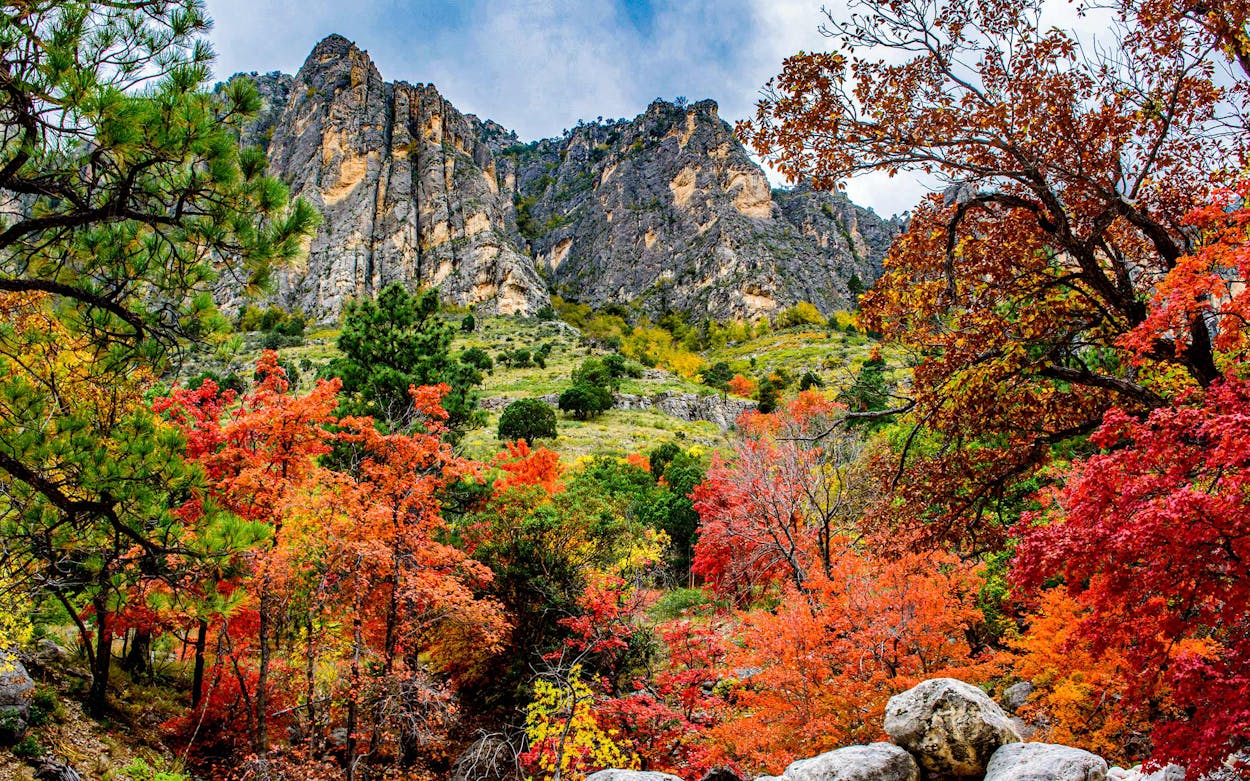It’s no secret that things are looking especially . . . crunchy this fall.
More than 93 percent of Texas is now suffering from some degree of drought, with nearly half the state experiencing severe, extreme, or exceptional drought conditions, as tracked by the U.S. Drought Monitor. Earlier this summer, the Texas Tribune reported that the drought was the worst it’s been since 2011. And while that’s bad for plenty of extremely important and far-reaching reasons, being deprived of Texas’s beautiful and oft-unexpected fall foliage is a particularly poignant one.
“For most of the state [the drought] really began back in winter,” says Karl Flocke, a woodland ecologist with the Texas A&M Forest Service. “So what we saw in the spring, when most of the trees would normally be leafing out, was many of them were a little delayed, and when they did leaf out, they had fewer and smaller leaves—largely a result of trying to conserve water.” For the trees that managed to produce and maintain leaves through the spring, a dry summer forced many leaves to prematurely turn yellow and brown and, in some cases, to drop ahead of schedule.
“In the end, some of the trees might have even died as a result of this drought,” Flocke says. “Many of those that didn’t haven’t really had a chance to fully recover from that intense summer, so instead of having a vibrant show of color this fall, most of them are kind of just going to slump their way into dormancy this winter.”
If slumping into dormancy wasn’t included in your autumnal fantasy, you’ll be relieved to hear there is still hope to be had for seeing colorful fall foliage in Texas this year. While rainfall is a strong indicator of tree health and leaf color, cooler temperatures also play a key role in prompting leaves to change colors.
“The other factor that really helps you get that vibrant show all at once is typically pretty strong, early-season cold weather,” Flocke says. “So a good, strong freeze in early to mid-November is really what triggers a lot of the trees to put on that flush of red. So, there is still hope, but the overall conditions leading into that first freeze have not been good here in Texas.”
When asked about his favorite spot for enjoying fall foliage, Flocke suggests leaf watchers head west for the best chance of seeing colorful leaves this season. “One place that is probably going to be pretty good—and, in fact, I’ve already seen good pictures coming out of it this year—is McKittrick Canyon in the Guadalupe Mountains. West Texas had a lot of rainfall this summer, so they should have some pretty good fall colors if you can get to the places where there are actually trees.”
Below are a few beloved spots to (fingers crossed) enjoy the marvel of Texas fall foliage.
Popular Spots to View Texas Fall Foliage
Lost Maples State Natural Area
It’s all in the name with Lost Maples, which is located near Vanderpool, about two hours northwest of San Antonio. Known for a plenitude of Uvalde bigtooth maple trees, the park is such a go-to for Texas foliage seekers that Texas Parks and Wildlife offers regular fall foliage color reports throughout the season so Texans know when it’s best to plan a visit. The most recent report says that recent rain and a cold spell “will be good for the colors this year.”
Guadalupe Mountains National Park
If you take Flocke’s suggestion to heart and opt for a trip to West Texas’s Guadalupe Mountains National Park, be ready for a hike. Most of the park’s foliage is best seen on foot, rather than from a car or on the park’s main roads. To access McKittrick Canyon, where oaks and maples are putting on a show, you have a few trail options.
Garner State Park
Garner’s limestone cliffs offer a picturesque contrast to the park’s often-vibrant mesquite, oak, cypress, and persimmon fall foliage. Visitors can pair their foliage spotting with views of the Frio River, which draws swimmers and paddleboarders, and camping here is always a treat. The park is about a thirty-minute drive north of Uvalde.
Daingerfield State Park
Rife with oak and cypress trees, Daingerfield State Park occupies a pretty patch of land in Morris County, deep in the Piney Woods of far East Texas. In a good year, the park welcomes a gradient of yellow, orange, and red foliage, which is particularly well viewed from the banks of Little Pine Lake.
- More About:
- Drought






